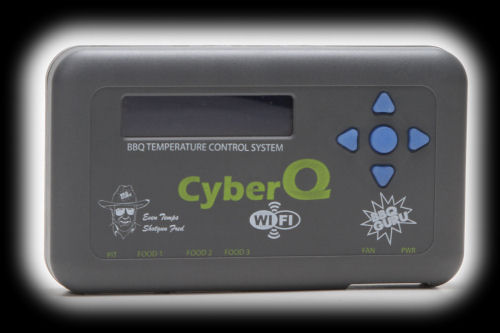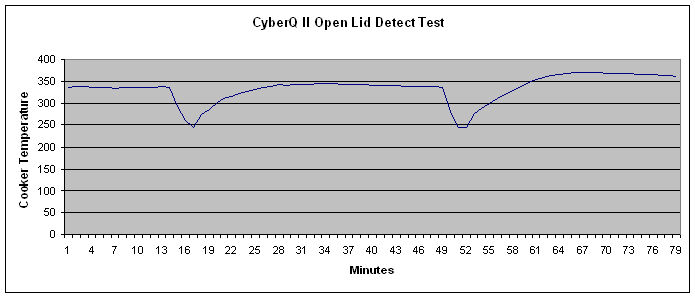 |
 |

You may remember that the original BBQ Guru Competitor had a "Good Neighbor Feature" which allowed you to disable the alarm so as not to disturb your neighbors. This feature is implemented on the CyberQ Wifi by means of options to disable alarms and to disable the beeper. Whether or not you liked the Audible Blower feature (the alarm sounded when the blower is actually running) on the original Competitor, it is gone on the CyberQ Wifi. Instead, blower operation is indicated on the main screen. After the four lines for the four temperature probes is the line for the blower output. What you will see is the word "Output" followed by a percentage and then an asterisk that appears when the blower is actually operating. The percentage tells you the percentage of the time that the blower is operating while the asterisk indicates when the blower is actually energized and moving air:  The CyberQ Wifi has an internal memory which retains all settings during a power loss. When power is returned to the unit, it will continue to operate as it did before the power loss, with all target temperatures and menu settings retained. What is Ramp Mode? It is a clever mode in which the CyberQ Wifi will lower the cooker temperature once the meat is within 30 degrees of being done. As the meat temperature rises closer and closer to the target temperature, the CyberQ Wifi will continue to lower the cooker temperature. Ultimately, when the meat temperature reaches the target temperature, the cooker will be kept at a slightly higher temperature in order to hold your meat at your target temperature. You activate and deactivate Ramp Mode through the CyberQ Wifi menus. Here are two graphs taken from the CyberQ Wifi owner's manual that should make Ramp Mode clearer:
The CyberQ Wifi allows you to enter a pit setpoint down to a temperature of 32 degrees. Therefore, there is no need any more for the foil-wrapped-probe-in-ramp-mode trick that you could use on the original Competitor get it to control the cooker at temperatures below 175 degrees. Just remember, though, that in order for the CyberQ Wifi to control the cooker at lower temperatures a good seal on your cooker is very important. Too much ambient airflow will prevent the CyberQ Wifi from keeping the fire low enough to maintain a low temperature. The CyberQ Wifi has a feature called "Adaptive Control", first introduced with the DigiQ II controller. The BBQ Guru describes it: "a full-time adaptive control algorithm learns your pit to control better stability/accuracy." If we understood Shotgun Fred correctly, over time, the unit learns how much effect the blower has so that it can more accurately and intelligently decide how long to run the blower when it needs to adjust or maintain the cooker's temperature. So for example, if the unit signals the blower to operate at 30% and it sees that the temperature overshoots a bit, it will gradually learn to run the blower at 20% instead. This "learning" is done on every use of the CyberQ Wifi and it does not get "remembered" from one use to the other. If you turn the unit off, it will start the learning cycle over again. This is goodness, obviously, as you might wish to use the unit on different cookers, and of course, circumstances can change from cook to cook. The "learning" process can take 10 to 20 minutes depending on different factors. Suffice it to say that if you are using the CyberQ Wifi on a long term cook, the unit works well initially and improves its control over time. Once again, we'll point out that your average kitchen oven will vary up to 50 degrees or more, so there's no reason to sweat over a few degrees. The CyberQ Wifi will do the job. You can read more about the adaptive control algorithm in the Cyber Wifi User's Manual. The CyberQ Wifi of course also includes the Open Lid Detect feature that was introduced in the DigiQ II controller. People have been proposing solutions for the problem of controllers operating the blower when you open the lid on various forums. Most of the solutions involve either a tilting mercury switch or some sort of mechanical switch to detect that the lid is open. The DigiQ II solved the problem algorithmically with no additional hardware, and so here it is carried on into the CyberQ Wifi. So, why have Open Lid Detect? With the older Competitor or ProCom4 controllers, when you opened the lid of the cooker, the temperature dropped and the blower started blowing non-stop. Ash might start blowing around the cooker and of course, the charcoal started burning hotter and hotter. By time you closed the lid, the temperature would be climbing and you would end up with a cooker that was a lot hotter than you intended. You quickly learned to disconnect the blower or close the damper before you opened the cooker, and after you closed the lid you waited until the cooker had nearly recovered its temperature before you allowed the blower to do its thing again. Those days were gone when the DigiQ II was released and we are pleased to say those days are still gone. Open Lid Detect works essentially by detecting sharp temperature changes and refrains from operating the blower during these changes. So if the temperature is rapidly dropping or if the temperature is rapidly rising, the blower will not operate. The rapid drop detection obviously helps the CyberQ Wifi detect the lid opening. The rapid rise detection helps the CyberQ Wifi detect the lid closing and prevents the blower from operating when it doesn't need to assist the return to the target pit temp. The only caveat you need to be aware of is that if you leave the lid open for a long period of time, the temperature of the cooker may stabilize at a low low temperature. The CyberQ Wifi will sense that the temperature has stabilized and will then operate the blower again. So you don't want to leave the lid open forever. Open the lid, get your business done, and then close it. One other benefit of using this feature is to prevent overshoot when you initially heat up the cooker. If your fire is large and having the blower on full-time is causing the cooker to heat up rapidly, Open Lid Detect will detect this rapid rise in temperature and start to cut back on the use of the blower. This will allow the temperature to rise in a more controlled manner and thus cut back on overshoot. We tested Open Lid Detect on the original CyberQ II controlling a medium Big Green Egg at a stable temperature. We then opened the lid for 30 seconds with Open Lid Detect enabled, and then closed the lid. We allowed the cooker to stabilize again and then repeated the test with Open Lid Detect disabled. Here are the results:
 With Open Lid Detect enabled (the left side of the graph), the cooker recovered back to the stable temperature with only a 4 degree overshoot. With Open Lid Detect disabled (the right side of the graph), the overshoot was 29 degrees and it took a long time for the cooker to return to the original temperature. So Open Lid Detect works quite well and is worth having turned on. The CyberQ Wifi has a countdown timer that you can set to any value up to 99:59:59. When the timer expires, you can specify one of four actions to be taken. First is no action. Second is for the cooker to hold at a temperature that you specify in setup. Presumably you would specify some low temperature intended to keep the food warm. Third, you can specify that an alarm be sounded. Finally, you can specify that the cooker should shut down. In essence, the blower will stop blowing and the cooker will slowly cool off. |
You can support this website by shopping at The Naked Whiz Website Store and Amazon.com
|